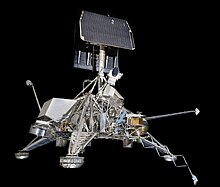Surveyor program
The missions called for the craft to travel directly to the Moon on an impact trajectory, a journey that lasted 63 to 65 hours, and ended with a deceleration of just over three minutes to a soft landing.The simple and reliable mission architecture was a pragmatic approach to solving the most critical space engineering challenges of the time, namely the closed-loop terminal descent guidance and control system, throttleable engines, and the radar systems required for determining the lander's altitude and velocity.The Surveyor missions were the first time that NASA tested such systems in the challenging thermal and radiation environment near the Moon.Each Surveyor mission consisted of a single unmanned spacecraft designed and built by Hughes Aircraft Company.The remainder of the trip to the surface, lasting about 2.5 minutes, was handled by smaller doppler radar units and three vernier engines running on liquid fuels fed to them using pressurized helium.The last 3.4 meters to the surface was accomplished in free fall from zero velocity at that height, after the vernier engines were turned off.The spacecraft returned data on the motion of the Moon, which would be used to refine the map of its orbital path around the Earth as well as better determine the distance between the two worlds.The Apollo 12 astronauts excised several components of Surveyor 3, including the television camera, and returned them to Earth for study.[8] Launched on July 14, 1967, Surveyor 4 crashed after an otherwise flawless mission; telemetry contact was lost 2.5 minutes before touchdown.[9] The planned landing target was Sinus Medii (Central Bay) at 0.4° north latitude and 1.33° west longitude.On January 20, while the craft was still in daylight, the TV camera clearly saw two laser beams aimed at it from the night side of the crescent Earth, one from Kitt Peak National Observatory, Tucson, Arizona, and the other at Table Mountain at Wrightwood, California.During the time of the Surveyor missions, the United States was actively involved in the Space Race with the Soviet Union.










Apollo 12soft landing on the MoonCape Canaveral LC-36Atlas-Centaurrobotic spacecraftsoft landingsextraterrestrial bodyJet Propulsion LaboratoryApollo programSurveyor 3National Air and Space MuseumLuna 9alpha scatteringHughes Aircraft Companyvernier enginesSurveyor 1soil mechanicsparking orbitretrorocketsmetersFlamsteedSurveyor 2Pete ConradLunar ModuleMare CognitumOceanus ProcellarumSurveyorfirst images to show what planet Earth looked like from the Moon's surfaceAlan BeanSurveyor 4telemetrysolid-fuelretrorocketSinus MediiSurveyor 5Mare TranquillitatisSurveyor 6Surveyor 7lunar surfacecrater TychoCopernicus craterTycho craterUnited StatesSpace RaceSoviet UnionAtlas (rocket family)Luna programmeLunar Orbiter programRanger programExploration of the MoonList of missions to the MoonLunar landingChang'e 4Chang'e 6Blue Ghost Mission 1Hakuto-R Mission 2Apollo 11Chandrayaan-3Chang'e 3EagleCamApollo 13BeresheetChandrayaan-2Hakuto-R M1Luna 5OMOTENASHIPeregrineArtemisArtemis IIILuna-GlobLuna 27Beresheet 2SpaceILHakuto-R M3ispaceMoonExMcCandlessSpacecraft missionsExplorationAmericanApolloLunar OrbiterLunar PrecursorPioneerRangerChineseChang'eIndianChandrayaanJapaneseJapanese Lunar Exploration ProgramSouth KoreanKorean Lunar Exploration ProgramRussianSovietCrewedLunokhodCAPSTONEChang'e 5-T1DanuriLunar Reconnaissance OrbiterQueqiao 1 and 2Tiandu-1ICUBE-QYutu-2TENACIOUSArgoMoonList of Apollo astronautsApollo 8Artemis IChang'e 1Chandrayaan-1ClementineExplorer 35Luna 10Lunar Orbiter 1Lunar ProspectorSMART-1SELENE (Kaguya, Okina, Ouna)LCROSSLuna 2Moon Impact ProbeRanger 4LandersApollo Lunar ModuleChang'e 5